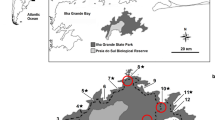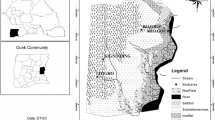Abstract
Arecaceae (Palmae) is an ecologically and economically important family characteristic of the vegetation in tropical and subtropical regions, with at least 125 species occurring in the Philippines, most of them endemics. We monitored changes in stem density, mortality and recruitment of palm populations for 12 years within a 16-ha Forest Dynamic Plot located in northern Luzon, the Philippines. We recorded a total of 4060 stems, dominated by Pinanga insignis (46%) and P. maculata (34%), followed by Caryota cumingii (19%), and a few stems (< 1%) of Orania decipiens and Areca whitfordii. Half (51%) of the initially recorded stems in the 2004 census died by the time of the 2016 census, while 1086 (36%) additional stems were recorded in the same period. Overall palm population declined with the decreasing populations of P. insignis and P. maculata due to higher mortality than recruitment during the 2004–2010 and 2010–2016 census intervals while C. cumingii population increased in the same period. Regarding topographic position, the stem density of P. maculata is higher in valleys > midslopes > ridges across censuses, higher in valleys and midslopes than ridges for C. cumingii across censuses, and higher in midslopes than valleys for P. insignis during the 2016 census only. Mortality and recruitment were weakly observed along topographic positions between species and across censuses. Our result presents how palm population may change within 12 years with population trends differing between species, indicating the importance of palms in understanding the population dynamics of plant communities in a fast-changing environment.





Similar content being viewed by others
Data availability
The datasets generated during and/or analysed during the current study are available from the corresponding author on reasonable request.
References
Adorador, J. T., & Fernando, E. S. (2017). Palms of Samar Island, Philippines. Palms, 61(4), 161–195.
Anderson-Teixeira, K. J., Davies, S. J., Bennett, A. C., Gonzalez-Akre, E. B., Muller-Landau, H. C., Joseph Wright, S., Abu Salim, K., Almeyda Zambrano, A. M., Alonso, A., & Baltzer, J. L. (2015). CTFS-Forest GEO: A worldwide network monitoring forests in an era of global change. Global Change Biology, 21(2), 528–549.
Breheny, P., & Burchett, W. (2017). Visualization of regression models using visreg. The R Journal, 9, 56–71.
Cinco, T. A., de Guzman, R. G., Ortiz, A. M. D., Delfino, R. J. P., Lasco, R. D., Hilario, F. D., Juanillo, E. L., Barba, R., & Ares, E. D. (2016). Observed trends and impacts of tropical cyclones in the Philippines. International Journal of Climatology, 36(14), 4638–4650.
Clark, D. A., Clark, D. B., Sandoval, R. M., & Castro, M. V. C. (1995). Edaphic and human effects on landscape-scale distributions of tropical rain forest palms. Ecology, 76(8), 2581–2594.
Co L, Lagunzad D, Lafrankie J, Davies S, Bartolome N, Yap S, Molina J (2004) Palanan forest dynamics plot: floristic diversity and stand structure of a lowland evergreen forest in NE Luzon, Philippines
Condit, R., Ashton, P. S., Manokaran, N., LaFrankie, J. V., Hubbell, S. P., & Foster, R. B. (1999). Dynamics of the forest communities at Pasoh and Barro Colorado: Comparing two 50–ha plots. Philosophical Transactions of the Royal Society of London. Series B, Biological Sciences, 354(1391), 1739–1748.
Corporal-Lodangco, I. L., & Leslie, L. M. (2017). Defining Philippine climate zones using surface and high-resolution satellite data. Procedia Computer Science, 114, 324–332.
Couvreur, T. L., & Baker, W. J. (2013). Tropical rain forest evolution: Palms as a model group. BMC Biology, 11(1), 1–4.
Davies, S. J., Abiem, I., Salim, K. A., Aguilar, S., Allen, D., Alonso, A., Anderson-Teixeira, K., Andrade, A., Arellano, G., & Ashton, P. S. (2021). ForestGEO: Understanding forest diversity and dynamics through a global observatory network. Biological Conservation, 253, 108907.
Eiserhardt, W. L., Svenning, J.-C., Kissling, W. D., & Balslev, H. (2011). Geographical ecology of the palms (Arecaceae): Determinants of diversity and distributions across spatial scales. Annals of Botany, 108(8), 1391–1416.
Emilio, T., Quesada, C. A., Costa, F. R., Magnusson, W. E., Schietti, J., Feldpausch, T. R., Brienen, R. J., Baker, T. R., Chave, J., & Álvarez, E. (2014). Soil physical conditions limit palm and tree basal area in Amazonian forests. Plant Ecology and Diversity, 7(1–2), 215–229.
Fernando, E. S. (1990). A preliminary analysis of the palm flora of the Philippine Islands. Principes, 34(1), 27–45.
Galetti, M., Donatti, C. I., Pires, A. S., Guimarães, P. R., Jr., & Jordano, P. (2006). Seed survival and dispersal of an endemic Atlantic forest palm: The combined effects of defaunation and forest fragmentation. Botanical Journal of the Linnean Society, 151(1), 141–149.
Ibanez, T., Keppel, G., Menkes, C., Gillespie, T. W., Lengaigne, M., Mangeas, M., Rivas-Torres, G., & Birnbaum, P. (2019). Globally consistent impact of tropical cyclones on the structure of tropical and subtropical forests. Journal of Ecology, 107(1), 279–292.
Johnson D (2011) Non-Wood Forest Products, 10/Rev. 1 Tropical palms 2010 revision. FAO Rome Italy
Kahn, F., & Mejia, K. (1987). Notes on the biology, ecology, and use of a small Amazonian palm: Lepidocaryum tessmannii. Principes, 31(1), 14–19.
Kassambara A, Kassambara MA (2020) Package ‘ggpubr’
Kissling, W. D., Balslev, H., Baker, W. J., Dransfield, J., Göldel, B., Lim, J. Y., Onstein, R. E., & Svenning, J.-C. (2019). PalmTraits 1.0, a species-level functional trait database of palms worldwide. Science Data, 6(1), 1–13.
Latifah, D., Congdon, R. A., & Holtum, J. A. (2017). Population structure of palms in rainforests frequently impacted by cyclones. Biodiversitas, 18, 41–50.
Monoy, C. C., Tomlinson, K. W., Iida, Y., Swenson, N. G., & Slik, J. F. (2016). Temporal changes in tree species and trait composition in a cyclone-prone Pacific dipterocarp forest. Ecosystems, 19(6), 1013–1022.
Montúfar, R., Anthelme, F., Pintaud, J.-C., & Balslev, H. (2011). Disturbance and resilience in tropical American palm populations and communities. Botanical Review, 77(4), 426–461.
Muscarella, R., Emilio, T., Phillips, O. L., Lewis, S. L., Slik, F., Baker, W. J., Couvreur, T. L., Eiserhardt, W. L., Svenning, J., & Affum-Baffoe, K. (2020). The global abundance of tree palms. Global Ecology and Biogeography, 29(9), 1495–1514.
Pelser P, Barcelona J, Nickrent D (2011) onwards. Co’s digital flora of the Philippines. URL https:philippineplants.org Accessed Sept 11:2021
Queenborough, S. A., Metz, M. R., Wiegand, T., & Valencia, R. (2012). Palms, peccaries and perturbations: Widespread effects of small-scale disturbance in tropical forests. BMC Ecology, 12(1), 3.
R Core Team (2019) R: A language and environment for statistical computing. Vienna, Austria: R Foundation for Statistical Computing; 2011. R-Proj
Salm, R., de Salles, N. V., Alonso, W. J., & Schuck-Paim, C. (2007). Cross-scale determinants of palm species distribution. Acta Amazonica, 37(1), 17–25.
Svenning, J.-C. (2001). Environmental heterogeneity, recruitment limitation and the mesoscale distribution of palms in a tropical montane rain forest (Maquipucuna, Ecuador). Journal of Tropical Ecology, 17, 97–113.
Treurnicht, M., Pagel, J., Esler, K. J., Schutte-Vlok, A., Nottebrock, H., Kraaij, T., Rebelo, A. G., & Schurr, F. M. (2016). Environmental drivers of demographic variation across the global geographical range of 26 plant species. Journal of Ecology, 104(2), 331–342.
Vormisto, J., Tuomisto, H., & Oksanen, J. (2004). Palm distribution patterns in Amazonian rainforests: What is the role of topographic variation? Journal of Vegetation Science, 15(4), 485–494.
Yap SL (2010) Phylogeography and Demography of Common Plant Species from the Philippine Islands. 154p. PhD Dissertation, University of Michigan, USA
Yap, S. L., Davies, S. J., & Condit, R. (2016). Dynamic response of a Philippine dipterocarp forest to typhoon disturbance. Journal of Vegetation Science, 27(1), 133–143.
Acknowledgements
The Palanan FDP was established through the collective efforts of the Isabela State University (Philippines), Conservation International, PLAN, Arnold Arboretum of Harvard University (USA), and the CFTS-ForestGEO. Research permits to work in the Northern Sierra Madre Natural Park (NSMNP) were issued by its Protected Area Management Board (PAMB) as well as the Department of Environment and Natural Resources Regional II (DENR R2) office. The support of the local government of Palanan, Isabela, and the local communities outside the plot had ensured that the plot continues to exist and perform its role in the global network. We are grateful to the many researchers, field assistants, and field guides who helped in the field sampling during each census.
Funding
No funding was received to assist with the preparation of this manuscript.
Author information
Authors and Affiliations
Contributions
BP and PO discussed and conceived the ideas of the manuscript. PO, MRD, and EF provided the data. BP performed the analyses and prepared the original draft. BP, MRD, and EF edited and approved the final manuscript for submission.
Corresponding author
Ethics declarations
Conflict of interest
The authors have no conflicts of interest to declare relevant to this article's content.
Informed consent
All authors agree to participate. All authors agree to publication.
Additional information
Perry S. Ong: Deceased 02 March 2019.
Rights and permissions
Springer Nature or its licensor holds exclusive rights to this article under a publishing agreement with the author(s) or other rightsholder(s); author self-archiving of the accepted manuscript version of this article is solely governed by the terms of such publishing agreement and applicable law.
About this article
Cite this article
Pasion, B.O., Duya, M.R.M., Ong, P.S. et al. Twelve-year changes in palm populations from a tropical lowland forest in the Philippines. COMMUNITY ECOLOGY 23, 327–335 (2022). https://doi.org/10.1007/s42974-022-00109-3
Received:
Accepted:
Published:
Issue Date:
DOI: https://doi.org/10.1007/s42974-022-00109-3




